23 Games for Walking Children to Develop Gross Motor Skills and Stay Active at Home
Exercise is really important for health and wellbeing. It maintains cardiovascular health (preventing conditions like stroke and heart disease), boosts mental health and self-esteem, and assists our bodies in managing blood sugar and insulin levels, which can help with weight control.
Exercise also has developmental benefits for children and young people. Physically, moving the whole body improves strength, stamina, endurance, stability and mobility. Cognitive skills boosted by movement include motor planning, problem solving and bilateral integration (using the two sides of the body and brain together).
No matter what fitness level or physical abilities our child has, moving a little bit more than normal will help them get fitter and stronger. Any movement counts – it doesn’t need to be traditional sport or exercise to have a big impact.
Below, we share lots of fun ideas for active games our children can play at home. If we have more than one child in the house these games can be played in a group; however we can also play 1-1 with our child, or they can practice the skills alone.
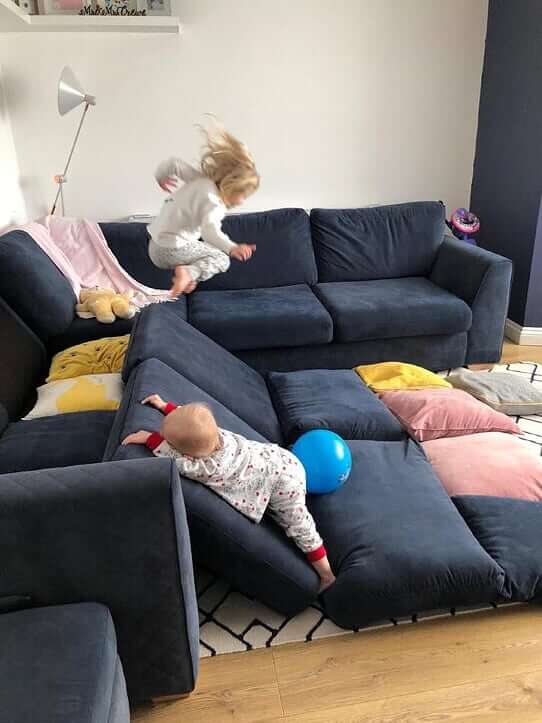
We all have a different level that we start from with exercise. These activities are in a sequence with the least challenging first. Find the level at which your child can comfortably have fun and make your way down the sequence as they get stronger, fitter and more coordinated.
As with all exercise, doing a little more than we are used to doing is the way to get fitter and stronger. If we do the same amount of effort every day we will not change our strength or fitness, so always try and progress the number of repetitions or tries that your child makes.
11 Fun Activities to Recreate at Home to Stay Active
Using balloons, crumpled paper or a pair of socks, you can make your ball sports more home-friendly.
The activities are suitable for children who can walk.
Start with a big soft ball and standing/ sitting very close together. Roll the ball into your child’s hands so they get used to holding it and balancing the ball between 2 hands.
Ask your child to throw it back and keep practising until they are accurate to you at a very small distance.
Start moving back a little so there is a gap between you.
Start making the ball a bit smaller-soft balls and beanbags are easier to catch than fully inflated balls. If you don’t have balls at home use rolled up socks or soft toys.
Move onto large inflated balls such as footballs and then move on to smaller or harder balls
Progress from 2 handed catches onto 1 handed catches
Try also catching on their own-throwing into the air or against a wall.
Try moving further apart from each other one step at a time to increase the challenge. If you are feeling brave try this outside with water balloons.
Obstacle course options are endless. Try to set it up to get your child to move in as many different ways as possible. For many other ideas for setting up an obstacle course for different abilities see our YouTube channel
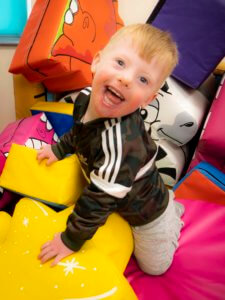 Use furniture to make your course – setting it up with the help of your child is a lovely way to get them active as they will need to carry and move furniture and objects with you. Let them come up with new obstacles as it will work their imaginations. You could have themes on different days- e.g. Pirates, Beach, Jungle, Castles etc.
Use furniture to make your course – setting it up with the help of your child is a lovely way to get them active as they will need to carry and move furniture and objects with you. Let them come up with new obstacles as it will work their imaginations. You could have themes on different days- e.g. Pirates, Beach, Jungle, Castles etc.
Once your obstacle course is set up, you can also add some extra stages and mark them with a piece of paper or some tape. For example:
Hopping on the spot
Long jumping (jump as far as possible with 2 feet or with 1 foot.)
Spinning in bear walk position/ crab walk position
Once you have set this up you can try these ideas to get them negotiate the obstacles in different ways to make it a little more challenging.
Try…
As a different animal
Backwards
While holding an egg and spoon
On one leg
Blindfolded with someone giving instructions of how to get through the course.
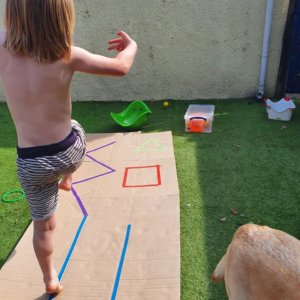 You can draw out an obstacle course with painters tape in a room or along your walls or with chalk in your garden or on the pavement. This great video can give you some ideas of how to set up an obstacle path on a pavement.
You can draw out an obstacle course with painters tape in a room or along your walls or with chalk in your garden or on the pavement. This great video can give you some ideas of how to set up an obstacle path on a pavement.Maybe put this along your corridor and your whole family can follow the steps each time they go through the corridor.
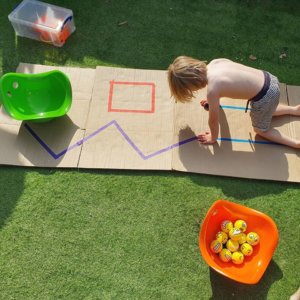 Painters tape works well as it doesn’t leave a mark when you remove it and is colourful.
Painters tape works well as it doesn’t leave a mark when you remove it and is colourful.
Make different shapes on the floor with tape or different objects – each one requires a different action – e.g. jump on the spot, do a star jump, touch your toes, do a press up.
You can use tape to make targets on the wall or floor. Can you hit the target?
Play musical shapes and whichever they land on when you stop the music is the action they must do.
For loads of other ideas of what to do with tape see this video.
Take photos of objects around your home on your phone or tablet. You can do this from unusual angles (e.g. from under a chair).
Or have a task in different areas (e.g. have clothes pegs on different materials) and take photos of them.
Give your child the phone/ tablet with the photos and the child needs to find each object around the house.
See this ‘Our Home’ video on an example of the game in action.
Elastics is a brilliant physical game to play on your child’s own or with 3 people.
This video shows the 10 different moves you can do on your own. All you need is 2 chairs and a long piece of elastic (tied to make a loop).
This mini series gives some examples of how you can put the 10 moves together.
If you have 3 people, you could try bringing the elastic higher each time you do a routine. You could see if you can do them at the ankles, knees, thighs, bottom and waist.
A skipping rope can give you hours of fun. Here are 2 videos which show you simple skipping through to more complex skipping games to keep your child occupied for hours.
Jumprope for Kids. Shows how to measure your rope and how to jump with the rope by your side until ready to skip.
Basic Jump Rope Tricks with Lauren MatsumotoGoes from simple skipping to some highly complex skipping.
Jumping is a fabulous workout for children.
If you don’t have a trampoline, your child can jump on the bed, off the sofa onto a pile of cushions (make sure the cushions won’t slip away as they bounce onto them) or just on the floor.
Try giving them challenges – how many jumps can they do in a row.
Can they throw and catch while they jump (this is harder than it sounds).
Can they jump back, forward and to the side, on 2 legs or 1?
-
Dancing is a brilliant form of exercise. There are numerous YouTube channels with music to dance along to for younger kids. Older children will probably prefer pop music, or they may have their own favoured genre! Turn up the music and let your child dance however they want to.
-
Our ‘Music at Home‘ page shares some ideas of YouTube channels to try. Find one song that your child especially likes. Help your child with the movements to start with and, over time, they may well anticipate the next movement and start to take over. This is a great way to get a daily workout into your child’s life.
-
This video from Flamingo chicks is the first in a series of inclusive dance videos which use Makaton and easy to follow steps to help your child to dance. They are each themed (this one is Space). Look out for more coming soon.
-
These videos from ‘Just Dance Kids’ demonstrate some dance routines for your children to follow along to nursery rhymes and other well known childhood songs.
Be aware that there are some reasons NOT to use a trampoline – such as if your child has had spinal rodding, There are several other times to be cautious so make sure you check with your physiotherapist before going on the trampoline for the first time with your child.
Trampolining is a fantastic, fully inclusive activity. Whether your child is mobile on the floor or starting to stand, they may well get benefits from having a bit of trampoline fun.
These Trampoline Tutorials take you through the basic trampoline techniques in a very thorough and well described way. Trampolining can be dangerous so we advise nets around the trampoline and supervision if your child is trying something new.
-
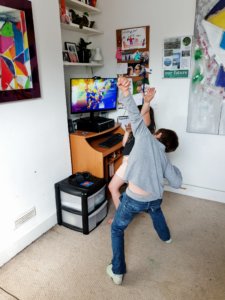 There are countless exercise and workout videos out there at different levels.
There are countless exercise and workout videos out there at different levels. Children who are wheelchair users and/or not yet walking may like these videos.
-
Mobile children may enjoy these exercise videos.
6 Sports to Play at Home
Table cricket is played by children with all disabilities. It is a great game to play with all the family and can be played using a regular table.
This video gives a quick demonstration of how to set up and play table cricket in the home.
Visit this video by the Lords Taverners Lord’s Taverners | Rules of Table Cricket for more detailed explanations of how to play this great inclusive game.
You can set up a volleyball court with a piece of string between 2 walls in a corridor or between 2 chairs. The aim is to make the balloon/ ball touch the floor on your opponent’s side of the string.
A corridor is great for this if your child has less accurate arm function as the walls keep the balloon in reach.
If your child has better hand/ eye coordination, put the 2 chairs with the string further apart so they have to move around more to retrieve the balloon.
Dribble a balloon around the house using a broom stick.
You could set up an obstacle course with chairs and a goal at the end for a single child game.
You could adapt it by keeping the balloon/ ball up in the air while they make their way around the house towards the goal.
This is a fantastic game and involves playing in teams and getting your team’s ball nearest to a target ball. It can be played with as few as 2 people and your child can play from their wheelchair or sitting on a bench or the floor.
If you don’t have balls, use rolled up socks.
See our video for details on the rules for this very inclusive game you can play anywhere.
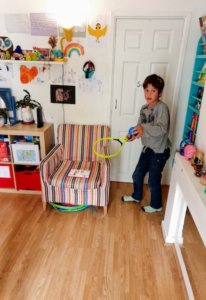 This great series Tennis at Home done by the Lawn Tennis Association (LTA) provides simple ideas to practice your tennis skills in your back garden or in a room with a few meters of space.
This great series Tennis at Home done by the Lawn Tennis Association (LTA) provides simple ideas to practice your tennis skills in your back garden or in a room with a few meters of space.If you don’t have a tennis racket you can still try these games with a fly swatter, any other kind of bat, a roll of wrapping paper or a broom. You could use socks, a balloon or scrunched up paper instead of a ball.
The activities vary in difficulty but most can be played from standing or sitting.
This mini series gives some fun activities to do at home which are loosely rugby focused. You don’t need a rugby ball and most of their activities use things you can find around the house. Some are indoor, some are outdoor.
6 Sports Day Games to Recreate at Home
 Ask your child to put their feet into a pillow case – getting their feet into the corners helps with this game.
Ask your child to put their feet into a pillow case – getting their feet into the corners helps with this game.They should then stand up and hold onto the top edge of the pillow case.
Try walking or jumping around the house. Be careful as this may be slippery on hard floors.
You could make this more physical by setting up an obstacle course for them to manoeuvre around, over and under while in the pillow case.
Be warned this may make holes in the pillow case!
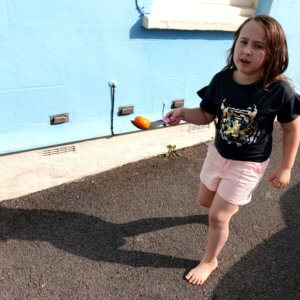 An egg and spoon race is a great way to challenge hand eye coordination while multi-tasking.
An egg and spoon race is a great way to challenge hand eye coordination while multi-tasking.
Use a large spoon and a small ball. The child must get from A to B without the ball falling of their spoon.
Progress this by putting obstacles in the way for your child to walk around
Progress to stepping over objects, going backwards or going around the whole house including up and down the stairs (make sure you stay close for safety).
Using a beanbag or soft toy is great for this game. Try to get from one end of the room to the other without it falling off your head.
Stand 2 children of similar sizes side by side with their feet next to each other.
If there aren’t 2 children, try this with your child but remember to remove your shoes to reduce the risk of stepping painfully on their feet!
Tie a dressing gown cord around the 2 people’s ankles. Make it nice and tight to make this more comfortable.
Hold each other close and try to walk.
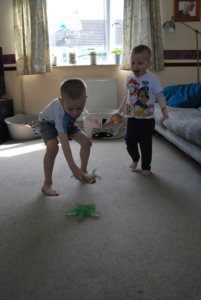 Set up several balls/ socks or beanbags about 1 meter apart with a bucket/ laundry basket at the end of the line (1m away).
Set up several balls/ socks or beanbags about 1 meter apart with a bucket/ laundry basket at the end of the line (1m away).Your child should start at the bucket end and run/walk to pick up the first ball/ beanbag.
They should then run/walk back to put it in the bucket.
Next go to the second ball and run back to put it in the bucket.
They should continue until all the beanbags are in the bucket.
Use a combination of the sports day ideas above to make a great relay race around your house, each person taking their turn to complete a challenge.


